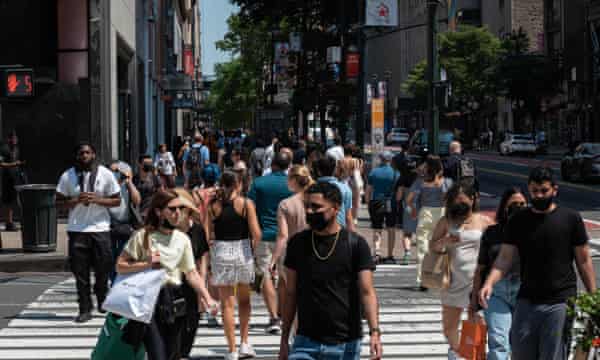
The United States is becoming more diverse more quickly than anticipated as minority communities grow while white populations shrink for the first time, the U.S. Census Bureau said Thursday as it released a new trove of data from the decennial count it conducted last year.
The data, which will be used to redraw political boundaries and administer hundreds of billions of dollars in federal, state and local programs over the coming decade, shed new light on a population that is growing both more slowly and more dramatically than anticipated.
Here are five takeaways from Thursday’s release:
The white population is shrinking
The number of white Americans is lower today than it was when the 2010 census was conducted. Today, whites account for about 57.8 percent of the population, the first time their share has ever dropped below 60 percent.
Whites have made up a progressively smaller share of the population in almost every census since the first one was conducted in 1790, but the raw number of white residents has never actually dropped in any prior 10-year period.
“The U.S. population is much more multiracial and more racially and ethnically diverse than we measured in the past,” said Nicholas Jones, director of race, ethnicity and outreach at the Census Bureau’s Population Division.
Demographers say there are a few reasons behind the decline: First, white women are waiting to have children until later in life. Second, when they do have those kids, they are having fewer than their predecessors in earlier generations.
Third, tragically, the opioid epidemic is having a real and demonstrable impact. The average U.S. life expectancy has declined for the last three years, beginning even before the pandemic, the most dramatic decline since the Spanish flu a century ago. That epidemic has fallen disproportionally on low-income, rural white America.
There’s a fourth and more technical explanation, one that comes from the Census Bureau itself: When they asked about a respondent’s race this year, they did it slightly differently than they had in previous decades. The bureau gave people more opportunity to identify as multiracial, to better capture a true portrait of America.
The multiracial population boomed over the last decade, and it certainly carved at least some people out of the white column. But it wasn’t enough to account for an overall decline among white Americans.
“Whites, no matter how you count them, declined since 2010,” said William Frey, a demographer and census expert at the Brookings Institute.
Every state got more diverse
In the last decade, the white share of the population dropped in all 50 states.
“The percentage of the country that is non-Hispanic white is decreasing and more and more jurisdictions, states, big cities are becoming majority people of color,” said Melissa Michelson, a political scientist at Menlo College who studies population trends. “People of color are gaining in power.”
Washington state saw its white population shrink by the largest margin of any state, down 8.7 percentage points over the last decade. Massachusetts, Nevada and Connecticut all saw declines of more than 8 percentage points as they become more diverse.
Six states are majority minority, meaning they have more minority residents than white residents: Hawaii, California, New Mexico and Texas were on that list 10 years ago. Now, Nevada and Maryland have joined them.
Even the whitest states in the nation got more diverse. In the last decade, four states — New Hampshire, West Virginia, Vermont and Maine — were more than 90 percent white. Now, only Maine is still above the 9-in-10 mark.
The only place it increased: Washington, D.C., where whites now trail Black Americans as a share of the population by just 2 percentage points.
Most minority groups are growing naturally
The number of Hispanic Americans has grown to 62 million, up 12 million over the last decade. The number of Black Americans is up almost 2 million. The number of Asian Americans has grown more quickly than any other race.
But it’s not because more people are moving to the United States. Indeed, thanks to the after-effects of the great recession, the Trump administration’s crackdowns on the border and — though it isn’t yet captured in the data released Thursday — the coronavirus pandemic, the number of immigrants who entered the United States in the last decade dropped precipitously.
Earlier population estimates show about three-quarters of the growth among Hispanic Americans came from natural increases — that is, births of new children. Only a quarter came from new immigrants entering the country.
“Though attention focuses on immigration, most of the growth in the Hispanic population is due to the excess of Hispanic births over deaths,” said Kenneth Johnson, a senior demographer at the Carsey School at the University of New Hampshire. “Hispanic growth cushioned the population declines fostered by non-Hispanic population loss.”
Asian Americans were the only minority group to achieve most of its population growth through immigration. But that is likely to change over time, as those new migrants have their own children and begin growing naturally too.
Population growth is slowing substantially
The United States population grew by 22.7 million in the last decade, to 331,449,281. That’s just over a 7 percent increase, and the second-slowest growth rate ever measured by a decennial census. Only the 1930s, the years after the Great Depression, had a slower rate of growth.
“Population decline was widespread this decade,” said Marc Perry, a senior demographer in the Census Bureau’s Population Division. “On average, smaller counties tended to lose population, and more populous counties tended to grow.”
Though the country isn’t at risk of losing population overall, the rising number of older Americans and the shrinking size of the average family carries the potential for economic problems down the road: There will be fewer people in the workforce supporting more who are retired.
“The best we can hope for is a slight gain or a steady state gain. We’re an aging population. Nationally, we’re having more deaths and fewer births,” Frey said. “The way we will solve that is to have more immigrants and their children.”
The suburbs are growing
A century ago, Republicans in Congress gummed up the reapportionment process as it became clear the 1920 census would show that more Americans lived in cities than in rural areas for the first time.
That trend hasn’t abated: More than half of America’s 3,183 counties lost population in the last decade, and counties with fewer than 50,000 residents were far more likely to lose population than gain.
On the other hand, the largest counties gained population, and five counties — the homes of Houston, Phoenix, Seattle, Las Vegas and Dallas — all added more than 300,000 new residents over the last 10 years.
“Population gains were greatest in suburban areas and least in remote rural areas. The suburbs had both natural increase and migration gains fueled both by domestic migrants and immigration,” Johnson said.
The growth isn’t limited to suburbs: All 10 of America’s largest cities added population in the last decade, including places like Chicago and New York City, which have seen net out-migration in the last few years.
But the suburbs are the areas growing the fastest. Consider King County, Seattle’s home: The city added 100,000 new residents over the last decade, which means 200,000 new residents moved into other towns and cities to be close to Seattle. Kent, a southern suburb just east of SeaTac Airport, was one of the fastest growing cities of the last decade.
Via The Hill


